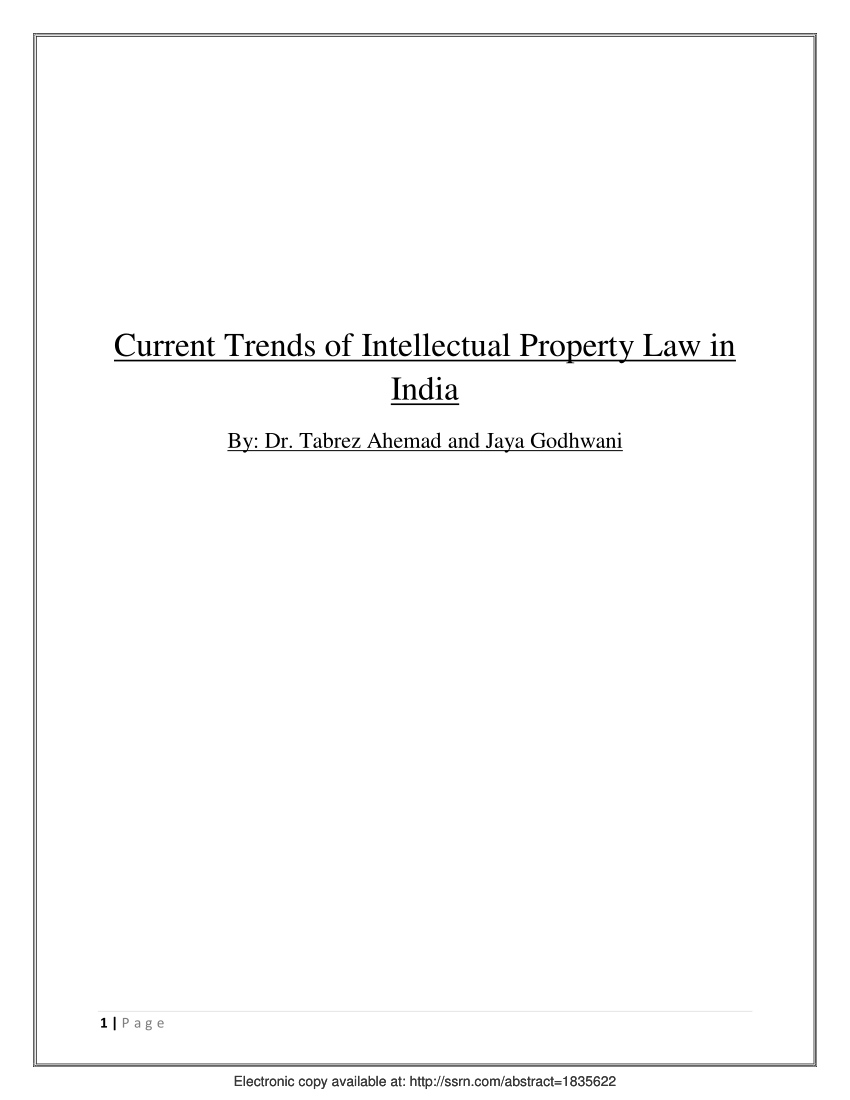Current Trends in Intellectual Property Law
Intellectual Property (IP) law is constantly evolving to keep pace with changes in society and technology. As innovations emerge, so do the challenges related to protecting creators’ rights. This blog explores the latest trends in IP law, highlighting how they affect businesses, artists, and consumers alike.
Importance of Intellectual Property in Today’s Economy

Intellectual Property plays a crucial role in fostering innovation and economic growth. Here are some key reasons why IP is important:
- Encourages Innovation: IP rights provide creators with the incentive to innovate by protecting their inventions and creations from unauthorized use.
- Enhances Business Value: A strong IP portfolio can significantly increase a company’s market value and attract investors.
- Protects Consumers: IP laws ensure that consumers can identify and purchase genuine products, enhancing trust in brands.
- Supports Job Creation: Industries that rely on IP rights contribute to job creation and economic stability.
In a competitive marketplace, businesses that leverage their intellectual property effectively can gain a significant advantage. As the economy increasingly relies on knowledge and creativity, understanding IP rights becomes essential for companies of all sizes.
Impact of Technology on Intellectual Property Rights
Technology is reshaping the landscape of Intellectual Property rights in several ways:
- Digital Piracy: The rise of the internet has made it easier for individuals to copy and distribute copyrighted materials, posing significant challenges for IP owners.
- Blockchain Technology: This technology is emerging as a tool for protecting IP rights by providing secure and transparent tracking of ownership and transactions.
- Artificial Intelligence: AI is creating new questions about authorship and ownership of creations produced by machines.
- Online Platforms: Social media and streaming services are transforming how IP is used and protected, requiring new legal frameworks.
As technology advances, it is crucial for IP laws to adapt accordingly to ensure that creators can protect their rights effectively while promoting innovation and access to information.
Recent Legal Developments in Intellectual Property
Intellectual Property law is always in flux, responding to new challenges and innovations. Recent legal developments highlight how courts and lawmakers are addressing these issues. Some notable changes include:
- Stronger Enforcement Measures: Courts are increasingly imposing stricter penalties for IP infringement, making it clear that violation of IP rights is taken seriously.
- Streamlined Processes: Many jurisdictions are adopting more efficient processes for resolving IP disputes, which helps creators enforce their rights more easily.
- International Treaties: Agreements such as the USMCA and changes in the European Union’s IP laws aim to harmonize protections across borders, making it easier for businesses to operate globally.
- Focus on Fair Use: Recent rulings have clarified what constitutes fair use in copyright law, offering more guidance for creators and users alike.
These developments signify a commitment to protecting intellectual property rights while also ensuring that the law remains relevant in an ever-changing landscape. It’s important for businesses and individuals to stay informed about these changes to protect their interests effectively.
Globalization and Intellectual Property Challenges
As businesses expand beyond borders, globalization presents unique challenges for Intellectual Property protection. Here’s how globalization affects IP rights:
- Diverse Legal Systems: Different countries have varying IP laws, which can create confusion and inconsistency for companies trying to protect their assets worldwide.
- Counterfeiting and Piracy: The global market makes it easier for counterfeit goods to circulate, undermining legitimate businesses and harming consumers.
- Trade Agreements: International trade agreements often include provisions for IP protection, influencing how countries shape their laws.
- Collaboration and Sharing: Globalization encourages collaboration, but it also raises concerns about sharing innovations without proper protections.
To navigate these challenges, businesses must understand the IP landscape in each market they enter. This knowledge is essential for safeguarding their innovations and maintaining competitive advantages.
Emerging Trends in Copyright Law
Copyright law is undergoing significant changes as new technologies and creative practices emerge. Here are some notable trends:
- Digital Content Protection: With the rise of streaming services and online content, there’s a stronger focus on protecting digital works from unauthorized use.
- Shorter Duration of Protection: Some discussions are ongoing regarding the length of copyright protection, with arguments for adapting it to better suit modern practices.
- User-Generated Content: Platforms that allow user-generated content are redefining copyright issues, especially regarding liability for infringements.
- Global Harmonization: Efforts to harmonize copyright laws across countries are gaining momentum, aiming to simplify enforcement and compliance.
Understanding these trends is crucial for creators and businesses as they navigate the complexities of copyright law. Staying informed helps protect their rights and ensures they can capitalize on their creative efforts effectively.
Future of Patent Law and Innovations
The future of patent law is poised for exciting changes as innovations in technology and business practices continue to evolve. This dynamic landscape raises new questions and opportunities for inventors and companies alike. Here are some key trends shaping the future of patent law:
- Emphasis on Artificial Intelligence: As AI technologies advance, the legal community is grappling with questions about patentability. Who owns an invention created by AI? Expect ongoing debates and potential legal reforms in this area.
- Streamlined Patent Processes: Many jurisdictions are working on simplifying the patent application process, making it easier for inventors to protect their creations without lengthy delays.
- Global Patent Cooperation: With businesses operating internationally, there’s a push for more global cooperation on patent law, aiming for more uniform protections across borders.
- Focus on Sustainability: Innovations addressing climate change and sustainability are becoming a priority in patent law, leading to potential incentives for eco-friendly inventions.
As we look ahead, staying informed about these trends will be essential for inventors and businesses. By understanding the evolving landscape of patent law, stakeholders can better protect their innovations and navigate potential challenges.
FAQ about Intellectual Property Law Trends
Here are some frequently asked questions regarding current trends in Intellectual Property law:
- What are the main trends in Intellectual Property law today? Recent trends include stronger enforcement of IP rights, the impact of technology on IP protection, and the globalization of IP laws.
- How do technological advancements affect IP rights? Technology has created new challenges, such as digital piracy and the complexities of protecting AI-generated works.
- What challenges do businesses face with globalization and IP? Businesses must navigate diverse legal systems and combat counterfeiting while seeking international protections.
- What changes are expected in copyright law? Emerging trends include a focus on digital content protection and the implications of user-generated content on copyright ownership.
These questions reflect common concerns in the realm of Intellectual Property law and highlight the importance of staying informed about these ongoing changes.
Conclusion on Current Trends in Intellectual Property Law
In conclusion, the field of Intellectual Property law is rapidly evolving, shaped by technological advancements, globalization, and emerging creative practices. Understanding current trends is crucial for businesses, creators, and legal professionals alike. By staying informed about recent legal developments, the challenges posed by globalization, and emerging trends in copyright and patent law, stakeholders can better protect their intellectual assets and foster innovation.
As we move forward, it’s essential to remain adaptable and proactive in navigating the complexities of Intellectual Property law. Whether you’re an inventor, an artist, or a business owner, keeping abreast of these trends will help you thrive in an increasingly competitive landscape.


